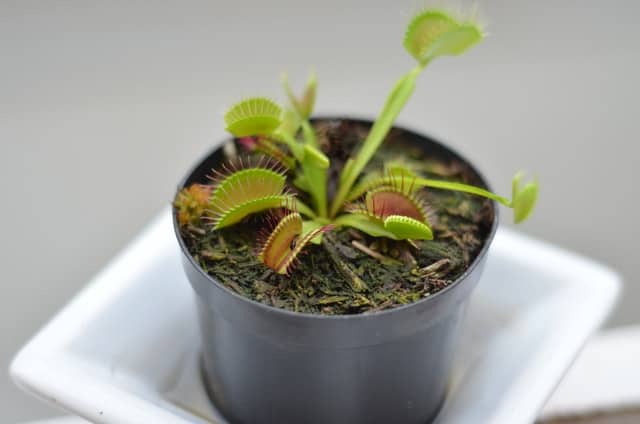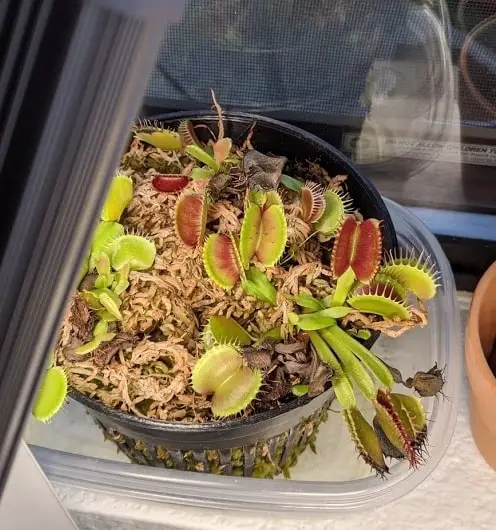There are a few different options you can implement to water a Venus flytrap. When I first started caring for Venus flytraps, I had many questions about the watering process, especially the strategy of letting them sit in water.
Venus flytrap pots sitting in water is a suitable method to provide enough moisture levels. Place the plant pot in a tray and fill the tray with a maximum of 1 inch of water. Watering them from the bottom prevents overwatering and encourages root growth.
Watering Venus flytraps from the bottom is an effective method. But, it must be done correctly to ensure the health of the plant.
Should Venus Fly Traps Sit in Water
Placing Venus flytraps in trays of water is a common practice since Venus flytraps require a continuously humid media. Still, many sources suggest Venus flytraps prefer not to be placed in standing water, which is also true.
Venus flytraps can sit in water, but they should not remain in the same water for extended periods. For that reason, when placing them on a tray of water, the water level should never exceed one inch in depth.
When you let Venus flytraps sit in water, you are watering the plant from the bottom. The potting media is slowly soaking the moisture, and the roots strengthen to reach the bottom of the pot and have access to water.
How to Water Venus Flytraps From the Bottom
Venus flytraps are accustomed to nutrient-free environments; they cannot process nutrients from the ground or water. Therefore, they can not be watered with regular tap water or bottled water. Those two water sources usually contain too many nutrients or minerals for carnivorous plants.
To water a Venus flytrap, always employ pure water sources: distilled water, rainwater, or reverse osmosis water. Watering a Venus flytrap from the bottom is an effective method. But using the incorrect water can kill your plant very quickly.
Now, let’s learn how to build a setup to water Venus flytraps from the bottoms. Here are the instructions:
- Gather your Venus flytrap in its pot, a gallon of distilled water ( you can employ rainwater or reverse osmosis water too), and a shallow tray big enough to bit the plant pot.
- Place the plant pot on top of the shallow tray.
- Pour the pure water sourced described in step one in the tray. Fill up the trap until the water is 1 inch deep.
- Do not water again until the tray has dried up. Then, fill up the tray again to reach a maximum of one inch.
- Repeat the process.
Venus flytraps are not aquatic plants. They should not live in swamp-like conditions. The method described in this section provides the amount of water Venus flytraps require without creating a soggy environment.
The picture below shows a Venus flytrap sitting in water. The 1-inch maximum prevents the ground from sitting on standing water for too long.

If you would like to learn more about watering Venus flytraps in general, you might want to read this article: Venus Flytrap Watering Procedure: Source, Frequency, and Tips. It contains all the information you need to know about Venus flytrap watering.
The Benefits of a Venus Flytraps Sitting in Water
Venus flytraps can be watered from the top or the bottom. Both are effective methods. I prefer placing my plants in a tray of water due to a few reasons:
- Avoid Soil compression: When watering from the top, soil tends to compress. The compression is not instant, but over time, the soil compacts. Compacted soil prevents healthy root growth and impedes drainage.
- Prevent overwatering: Almost everyone that has owned plants is guilty at some point of overwatering them. Generally, it is much easier to overwater a plant than to underwater it. By using the tray method, you are far less likely to overwater your venus flytrap.
- Consistent moist environment: I have lost a few plants due to excessive heat. Even though I try to water them often enough, some summers can be tough on plants. For example, when Venus flytraps do not receive enough water, they look droopy and can dry up and die. It is difficult to remember to water them so often, so I resort to water them from the bottom and always have a reserve.
- Added humidity: The water in the tray provides extra moisture in the environment. It might not be necessary for the plant’s survival, but Venus flytraps do appreciate it.
Tips For Watering From The Bottom
You have learned all the benefits from water Venus flytraps from the bottom. But, all of those benefits only exist if you follow the correct procedures. I have summarized some useful tips to ensure you always water your plant correctly.
1.- Employ well draining soil
Venus flytraps require a humid environment to thrive, but the water within the potting media must continuously drain the soil. For best results, employ potting media that contains moss, either peat or sphagnum, and a draining agent. Perlite or sand are both great candidates. They help aerate the soil and prevent rotting. You can mix a moss with a draining agent at a 1:1, 2:1, 3:1 ratio, or something in between. The mix does not have to be exact as long as it contains at least 10% of sand or perlite.
2.- Use tall pots for your plant
Venus flytraps can develop very long roots. Tall pots assist Venus flytraps and promote root growth. Mature Venus flytraps can be potted in 6 inch deep containers. Such depth provides enough vertical space for the roots while stimulating growth.
3.- Test the soil moisture levels
Watering from the bottom is a useful practice that keeps the ground moist at all times. Still, the soil should never be soaking wet. You can test the moisture level by pressing on the soil. Make sure the ground is moist, but it is not flooded.
4.- Plastic, Styrofoam, and Glazed Ceramic are good tray materials
Just like with pots, Venus flytraps prefer materials that do not leach any compound into the ground. Unglazed ceramic, clay, or metal tens to cause problems for Venus flytraps. The trap you employ to water your plant should also follow the same considerations.
Plastic, styrofoam, and glazed ceramic trays are appropriate.

5.- Avoid overwatering to prevent algae and potential rotting
Watering from the bottom prevents potential problems with rotting and algae. Still, sometimes Venus flytrap owners overwater their plant by always keeping the tray full of water. Overwatering can lead to the development of algae in the ground and water. Algae won’t hurt the plant, but the green coloring is not very appealing.
Another issue that arises from overwatering is root rot. Root rot is serious, as it can kill the plant. You can read about root rot in this article. It will help you detect if your plant is suffering from rotting and guide you on how to fix it.
6.- Change the watering frequency through the seasons
Temperature changes will affect the watering frequency. When growing Venus flytraps outdoors, remember some of the water will evaporate, especially in the summer months. Adjust your watering schedule accordingly. Always wait until the tray dries up before watering.
Watering Venus Flytraps Before Traveling
The water tray method is not the only practice. Some Venus flytrap owners water their plants from the top regularly to provide appropriate moisture levels. Still, when leaving your plants for extended periods, the water tray method is sometimes the only choice.
Sometimes you can ask a neighbor or a friend to water your plants when you are gone, but it is not always a viable solution.
During the summer, I water my carnivorous plants very often. Every two to three days, I have to refill the trays. In the winter, I only have to refill the water once every five days or even a week.
Depending on the season, you can weigh in some alternatives on leaving your plants alone. During short trips (a few days to 2 weeks), you can fill up the water tray higher than usual, to 2-3 inches. Filling up the tray to such depth is not a sustainable practice, but it can be a solution when there are no other options.
The soil of a Venus flytrap should never dry completely. If you leave a plant without enough water, it can dry up and die. Overwatering the plant for a few days can create damage, but it won’t will it immediately. In most cases overwatering for a short time won’t cause any issues at all.

